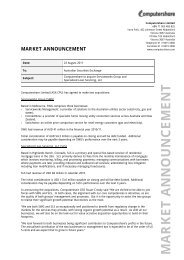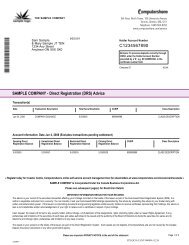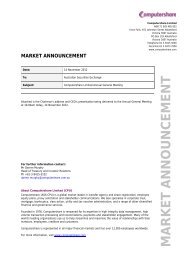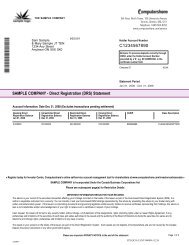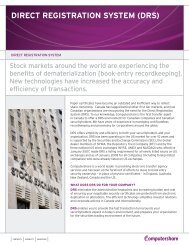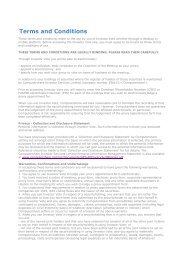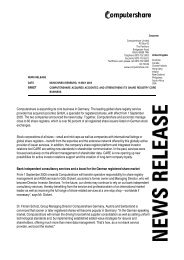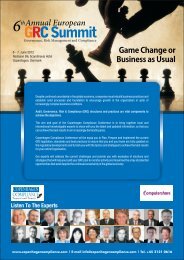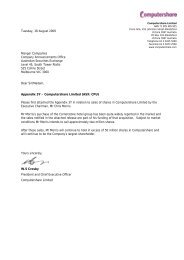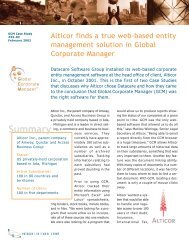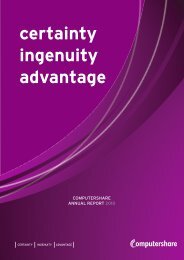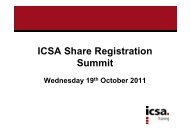COMPUTERSHARE ANNUAL REPORT 2008
COMPUTERSHARE ANNUAL REPORT 2008
COMPUTERSHARE ANNUAL REPORT 2008
Create successful ePaper yourself
Turn your PDF publications into a flip-book with our unique Google optimized e-Paper software.
With limited exceptions, the Company’s share plans were in place prior to the release of the ASX Corporate Governance Council’sbest practice recommendations and were not submitted to shareholders for approval at the time of their adoption, other than incertain cases where approval was required under the Corporations Act 2001 (Cth). The most recent of these plans, the DeferredLong Term Incentive Plan (“DLI Plan”) was submitted to, and approved by, shareholders at the annual general meeting held inNovember 2005.02-13OverviewThe Board considers that, as a general rule, the composition of executive remuneration and equity-related employee incentiveplans are the domain of the Board, subject to meeting the Company’s statutory and ASX Listing Rule disclosure obligations. It isnot the current intention of the Board to submit or re-submit details of its existing share and option plans that were adopted priorto the release of the ASX’s best practice recommendations to shareholders for approval. However, the Board proposes to submitall subsequent or new plans for executive equity-based remuneration, such as the DLI Plan, for approval by shareholders at ageneral meeting.9. REVIEW OF BOARD AND EXECUTIVE PERFORMANCEA review of the Board has taken place during the reporting period in accordance with Computershare’s performance evaluationprocess for directors. This was an informal review whereby the Nomination Committee (which consists of all members of theBoard) considers the performance of the Board and any steps that could be taken to maintain its effectiveness. The Board believesthat, given the qualifications and experience of each individual director and as the Board works well together in considering thebest interests of the Company, a more formal performance evaluation process was not required. The Board annually reviews theperformance of the senior management group. A summary of the performance evaluation process for directors and executives wasavailable on Computershare’s website throughout the reporting period.14-36Governance10. IDENTIFYING AND MANAGING BUSINESS RISKSThere are a variety of risks that exist in the markets in which Computershare operates and there are a range of factors, some ofwhich are beyond the control of Computershare, which may impact the Group’s performance.The Board, in conjunction with the Risk and Audit Committee, reviews and approves the parameters under which such risks aremanaged, including the responsibility for internal control systems, the procedure for identifying business risks and the methods tocontrol their financial impact on the Group. The Board has approved a Risk Management Policy, a summary of which is available onthe corporate governance section of the Computershare website – www.computershare.com. In essence, the policy is designed toensure that strategic, operational, legal, reputational and financial risks are identified, evaluated, monitored and mitigated to enablethe achievement of the Group’s business objectives.37-88FinancialsThe Chief Executive Officer and senior management team are instructed and empowered by the Board to implement risk managementstrategies co-operatively with the Risk and Audit Committee, report to the Board and the Risk and Audit Committee on developmentsrelated to risk, and suggest to the Board new and revised strategies for mitigating risk.The Global Enterprise Risk and Audit Manager (“GERAM”) is a senior role with responsibility for providing counsel and direction inrisk management across the Group. This includes counsel on the refinement, implementation and monitoring of a comprehensiveand integrated risk management framework based on unit manager ownership of risk with independent monitoring. The GERAMreports directly to the Group’s Chief Executive Officer with a dotted line to the Chairman of the Risk and Audit Committee.The role of Internal Audit as part of the Group’s risk management framework is to understand the key risks of the organisationand to examine and evaluate the adequacy and effectiveness of the system of risk management and internal controls used bymanagement. Internal Audit carries out regular systematic monitoring of control activities and reports to both relevant businessunit management and the Risk and Audit Committee.89-92ReportsTypically, the audit methodology includes performing risk assessments of the area under review, undertaking audit tests, includingselecting and testing audit samples, reviewing progress made on previously reported audit findings and discussing internal controlor compliance issues with line management, and reaching agreement on the actions to be taken.11. CORPORATE <strong>REPORT</strong>INGThe Chief Executive Officer and Chief Financial Officer have made a statement to the Board of Directors in respect of the yearended 30 June <strong>2008</strong> as detailed on page 90 of this Annual Report.12. CONFLICT OF INTEREST AND INDEPENDENT ADVICEIf a director has a potential conflict of interest in a matter under consideration by the Board or a Committee of the Board, thatdirector must abstain from deliberations on the matter. In that circumstance, the director is not permitted to exercise any influenceover other Board members or Committee members on that issue nor receive relevant Board or Committee papers.The Company permits any director or Committee of the Board to obtain advice about transactions or matters of concern at theCompany’s cost. Directors seeking independent advice must obtain the approval of the Executive Chairman, who is required to actreasonably in deciding whether the request is appropriate.93-96Further InformationPAGE 19



